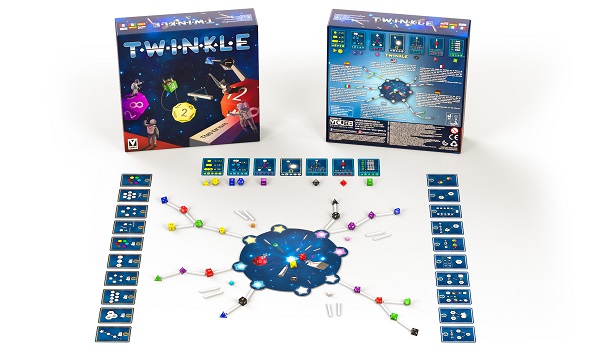Twinkle, Twinkle, Dicey Star: How I Wonder How You'll Score!

Build your constellation one die at a time! But choose your dice carefully, as you can only connect a lower die result to a higher one, and each color of die has a unique way of scoring.
Published by V Games, Twinkle is a clever dice drafting game that packs a lot into a tight gameplay length of fifteen minutes.
Gameplay
The round board is set in the middle of the table. The two starting stars with a matching color facing you are your starting stars. Depending on the player count, you set four-to-six scoring cards on the table. Each one is for a specific dice color. There are five dice of each color: a four-sided die, as well as a six, eight, ten, and twelve-sided die. You play all the dice of each color under their respective scoring cards, except for the eight-sided dice. You roll all the eight-sided ones and place them on the center of the board. Each player then takes seven of the long, thin white connectors.
You are building a constellation. On your turn, you either take one of the eight-sided dice from the center of the board without rolling it and add to it your constellation, or you choose any three dice and roll them and add one of them to your constellation. When rolling three dice, you may select one or more of the eight-sided dice from the center of the board to roll, but if you do not use them you must return them to the board without changing their new results.
When adding a die to your constellation, you use a connector to attach it to either a starting star or to a previously placed die, and then place the new die below it. Each die and each starting star can only have up to two connectors directly attached to it. You may only connect a die to another die if the new die’s number is less than the original die’s number. You must add a die to your constellation on your turn if legally allowed. If, after rolling, you cannot place a die, then you pass your turn.
The game ends once everyone has used all seven of their connectors. A player may need to take extra turns at the end of the game if they had to pass previous turns and are left with extra connectors unless it would be impossible for them to legally add any more dice.
After the game ends, players count up their points with each color scoring in a different way. Yellow dice score based on the quantity you have in your constellation. Blue dice score extra points if two of them are connected to the same die or starting star. Each green die is worth one point, plus another point for each same-sized dice in your constellation. Black dice score based on the sum of their results under each of your two starting stars. Purple dice score based on the number of dice they are connected two. Finally, a red die scores based on the number of even or odd dice results in the line of dice the red die is part of. Players also score an additional two points each time they have a die with more sides beneath a die with fewer sides.
There is also an advanced variant in which mission cards are randomly selected for each game. These provide additional scoring bonuses, such as giving three points to the player with the fewest different dice colors in their constellation or three points to each player who used each size of dice.

Review
Twinkle is such a well-made and clever dice game. The fact that players are all drafting from the same dice pools and that there are such a limited number of each color means that every single turn you have to decide exactly how important each color is to you at that moment, while keeping in mind how each one scores. Different colors can also combo off each other in clever ways, such as the green or the red.
This game does what you want from a dice game: there is the luck of the roll involved as you roll on your turn, but there are elements to mitigate how badly that can affect your plans. Since you can connect from each point twice, you’re also almost never going to end up completely stuck, and since you choose which size dice to roll you also have some control over the range of numbers you’ll be getting.
The mission cards also add a lot of variety to the gameplay, since there are twenty of them and each one brings a unique scoring rule to the game. This really increases the game’s replay value.
Some of the artwork on the cards could be a little fancier, and some of the iconography isn’t immediately clear, but the components are all sturdy and the rulebook is well written with lots of images and examples to make the game super easy to learn. The game also looks pretty impressive at the end, once all the constellations have been created, particularly at a full player count.
Twinkle plays in about fifteen minutes, which is the perfect length for this game. It’s so fast but packs quite a lot into that time. You have fun choices, the player interaction comes in the speed at which the dice pools shrink, and the game scales nicely across all player counts.
Pros: Game length, rule book, variety of scoring cards
Cons: Some of the artwork and iconography could be improved
Disclosure: we received a complimentary review copy of this game.






